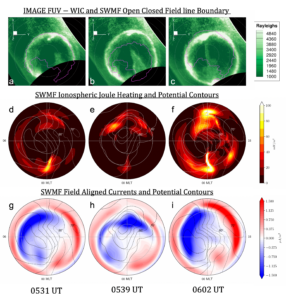Auroral light is created when ions and electrons precipitating from outer space collide with upper atmosphere ions and molecules. The return from excited to ground state leads to emission of photons mainly in the visible and ultraviolet wavelengths, which create the auroral forms seen in the northern and southern polar regions. The auroras mostly occur in oval-shaped bands encircling both magnetic poles, with brightness and forms varying as function of geomagnetic activity.
Auroral observations can be used to study space processes, as the intensity and color of the light tell us about the precipitating particles causing the excitations. However, the ionosphere is not only a passive recipient of the incoming particle flux – the electric conductivity, the neutral winds, and other characteristics of the upper atmosphere feed back to outer space shaping the flux of incoming particles. The magnetosphere – ionosphere coupling processes create further complexity to the geospace dynamics.
We use auroral observations, space-borne measurements and numerical simulations to study the nature of the magnetosphere – ionosphere coupling and the feedback of the ionospheric processes on the magnetospheric dynamics.

